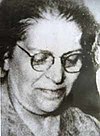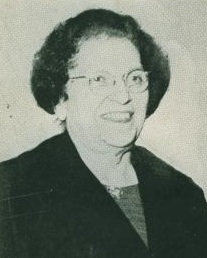| Sediqeh Dowlatabadi | |
|---|---|
| صدیقه دولتآبادی | |
 | |
| Born | 1882 Isfahan, Iran |
| Died | July 30, 1961(1961-07-30) (aged 78–79) Tehran, Iran |
Sediqeh Dowlatabadi (Persian: صدیقه دولتآبادی listen; 1882 in Isfahan – July 30, 1961 in Tehran) was an Iranian feminist activist and journalist and one of the pioneering figures in the Persian women's movement.
On one of the occasions when Dowlatabadi was arrested for her activities, she replied:
Sir, I was born a hundred years late, if I had been born earlier, I would not have allowed women to be so humiliated and trapped in your chains.
Early life
Dowlatabadi was born in 1882 in Isfahan. Her father was Hadi Dolatabadi and her mother was Khatameh Begum. Her father was a progressive religious jurist and allowed Dolatabadi to begin her education in Persian and Arabic in Tehran. She then continued her secondary education at Dar-ol-Fonoun Academy. Aged 15, she married Etezad al-Hakma, but they divorced because Dowlatabadi was infertile.
Career

Dowlatabadi believed that the only route for the advancement of women was through their education. In 1917, she founded one of the first girls' primary schools, called Umm Al- Madaris (Mother of Schools). The school was closed after objections from religious conservatives and Dowlatabadi was beaten and detained for three months as a result.
In order to educate, she recognised that women needed news and articles that addressed their issues and concerns. This led her to establish the first women's gazette in Isfahan called Zaban-e Zanan in 1919. This was the third women's newspaper to be published in Iran, and ran for 57 issues until 1921. It was notable for its progressive stance and the outspoken nature of its articles on women's rights. In her first editorial in it she pronounced that paper wanted to challenge the "backwardness and feeble-mindedness" of women's rights in the city. She also established the Women's Association of Isfahan at this time.
When the Second Eastern Women's Congress was arranged in Tehran in 1932, Shams Pahlavi served as its president and Dowlatabadi as its secretary.
Dowlatabadi was an opponent of British involvement in Iran. Together with other like-minded women, she expressed her opposition to the agreement by boycotting imported goods and going to coffee shops and encouraging them not to use foreign sugar.
From 1925, there was a debate within the intellectual community, newspapers and women's magazines in Iran about the unveiling of women and whether it could act as a modernizing force in the country and increase women's participation in society. During the late 1920s and 1930s there were rumours that the government planned to introduce a policy of compulsory unveiling (the reform, known as Kashf-e hijab, was promulgated in 1936). Dowlatabadi was an outspoken advocate for the unveiling of women. However this led to threats against her life.
In 1926 she attended the International Alliance of Women's Conference in Paris and on her return wore European clothes and refused to wear a veil. She is believed to have been the first woman to have done so, appearing in public in 1928 completely unveilied. Another advocate for unveiling was Khadijeh Afzal Vaziri, who campaigned for change in fashion alongside Dowlatabadi. When the Shah banned the veil in 1936, Dowlatabadi was an active supporter of the reform, and engaged in the new women's committee Kanun-e Banuvan (Ladies Society) formed by the government. The committee was led by the Shah's daughter Princess Shams to unite women organisations and prepare women for unveiling.
By 1941, Dowlatabadi was Director of the Women's Centre, however the organisation had little autonomy - for example they needed permission from the Ministry of Education to organise a commemoration of the poet Parvin Etesami.


Dowlatabadi died on 27 August 1961 at the age of 80 in Tehran. She had been ill with cancer. She was buried next to her brother in the Imamzadeh Ismail Cemetery in Zargandeh, however during the 1978 Revolution her tomb was damaged and her remains desecrated.
Legacy

Some of Dowlatabadi's archive is kept at the World Foundation for Social Research in Amsterdam. Part of this archive was exhibited in February 2016 at an exhibition on the background of the women's movement.
References
- ^ "THE UNIQUE SEDIQEH DOWLATABADI". SUBSTANCE MAGAZINE. 2020-09-07. Retrieved 2020-12-14.
- ^ "Iranian Personalities: Sediqeh Dowlatabadi". www.iranchamber.com. Retrieved 2020-12-14.
- ^ "شبکه بین المللی همبستگی با مبارزات زنان ايران". www.iran-women-solidarity.net. Retrieved 2020-12-14.
- Monshipouri, Mahmood (2006). "Review of Religion and Politics in Modern Iran: A Reader". Middle East Studies Association Bulletin. 40 (2): 271–273. doi:10.1017/S002631840005015X. ISSN 0026-3184. JSTOR 23062905. S2CID 164551411.
- Moghissi, Haideh (2008-04-01). "Islamic Cultural Nationalism and Gender Politics in Iran". Third World Quarterly. 29 (3): 541–554. doi:10.1080/01436590801931504. ISSN 0143-6597. S2CID 145128290.
- ^ "ZABĀN-E ZANĀN – Encyclopaedia Iranica". www.iranicaonline.org. Retrieved 2020-12-14.
- ^ Childress, Diana (2011-01-01). Equal Rights Is Our Minimum Demand: The Women's Rights Movement in Iran 25. Twenty-First Century Books. p. 33. ISBN 978-0-7613-5770-4.
- ^ Afary, Janet (2009-04-09). Sexual Politics in Modern Iran. Cambridge University Press. ISBN 978-1-107-39435-3.
- ^ Beck, Lois; Nashat, Guity (2004). Women in Iran from 1800 to the Islamic Republic. University of Illinois Press. ISBN 978-0-252-07189-8.
- Chehabi, Houchang E. (1993). "Staging the emperor's new clothes: dress codes and nation‐building under Reza Shah". Iranian Studies. 26 (3–4): 209–233. doi:10.1080/00210869308701800. ISSN 0021-0862.
- "Women's Center | Foundation for Iranian Studies". fis-iran.org. Retrieved 2020-12-15.
- Zargarian, Tannaz (2020-08-11). "Iranian Women's Quest for Self-Liberation through the Internet and Social Media: An Emancipatory Pedagogy".
{{cite journal}}: Cite journal requires|journal=(help) - Moghissi, Haideh (2005). Women and Islam: Women's movements in Muslim societies. Taylor & Francis. p. 231. ISBN 978-0-415-32421-2.
- Moghissi, Haideh (1996), Moghissi, Haideh (ed.), "Women and Social Reforms", Populism and Feminism in Iran: Women’s Struggle in a Male-Defined Revolutionary Movement, Women’s Studies at York Series, London: Palgrave Macmillan UK, pp. 37–53, doi:10.1007/978-1-349-25233-6_3, ISBN 978-1-349-25233-6, retrieved 2020-12-15
- ^ "Iranian Women you Should Know: Sediqeh Dowlatabadi". IranWire | خانه. Retrieved 2020-12-14.
- ^ PDN (8 February 2016). "Persian Feminism Exhibition in Amsterdam | نمایشگاهی از پیشینه جنبش زنان ایران در آمستردام | Persian Dutch Network | شبکه ایرانیان هلند". Retrieved 2020-12-15.
Further reading
- Sediqeh Dowlatabadi: Letters, writings and memories, ed. by Afsaneh Najmabadi & Mahdokht Sanati, 3 vols. (Midland, Chicago 1998).
- Jasmin Khosravie, Zabān-i Zanān – The Voice of Women. Life and Work of Ṣadīqa Daulatābādī (1882–1961) (EB-Publishers, Berlin 2012).
- Mohammad Hossein Khosroupanah, The aims and the fight of Iranian women from the Constitutional Revolution until the Pahlavi dynasty (Payam-e Emruz, Tehran 2002).
- Afsaneh Najmabadi, Women with mustaches and men without beards: Gender and sexual anxieties of Iranian modernity (Univ. of California Press, Berkeley 2005).
- Eliz Sanasarian, The women’s movement in Iran: Mutinity, appeasement, and repression from 1900 to Khomeini (Praeger, New York 1982).
External links
![]() Media related to Sediqeh Dowlatabadi at Wikimedia Commons
Media related to Sediqeh Dowlatabadi at Wikimedia Commons